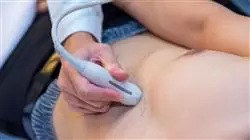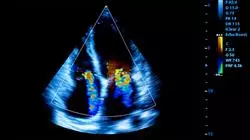University certificate
The world's largest faculty of nursing”
Introduction to the Program
We offer you the best specialization of the moment so that you can improve your qualifications as a nurse”

For the work of emergency and intensive care nurses, it is essential that they have a perfect knowledge of clinical cardiovascular ultrasound, which will allow them to perform their work more effectively. Specifically, by studying this specialization they will be trained in the use of ultrasound devices in the management of emergency and critical care situations, with total guarantees of effectiveness and confidence.
It must be taken into account that clinical ultrasound is a tool that helps to diagnose and treat patients in emergency situations or with intensive care needs. Today, it is one of the most popular and valuable tools for guiding diagnostic and therapeutic interventions. In addition, it has the advantages of portability, accuracy, real-time display, reproducibility and efficiency.
Technological advances have made it possible to reduce the size of the equipment, making it cheaper and more portable, and have increased the capacity of clinical ultrasound, leading to a notable increase in its applications. Nowadays, more accurate ultrasound diagnosis, safe ultrasound-guided interventions, precise non-invasive hemodynamic evaluations and rapid assessment of traumatic injuries are all possible.
In this Postgraduate diploma, TECH offers students the most complete specialization program on clinical ultrasound, specifying its use in the care of patients who find themselves in emergency situations or those who need intensive care. Additionally, as it is a 100% online training, the student will have the opportunity to combine their studies with the rest of their daily obligations, so that they will be able to improve their training in a comfortable way.
Technological advances have led to improved ultrasound scanners, which are becoming more useful and can be used in more situations"
This Postgraduate diploma in Clinical Cardiovascular Ultrasound in Emergencies and Intensive Care for Nursing contains the most complete and up-to-date scientific program on the market. The most important features include:
- Clinical cases presented by experts in clinical ultrasound in emergencies and intensive care
- The graphic, schematic, and practical contents with which they are created provide scientific and practical information on the disciplines that are essential for professional practice
- Latest developments in Clinical Cardiovascular Ultrasound in Emergencies and Intensive Care
- Practical exercises where self-assessment can be used to improve learning
- An algorithm-based interactive learning system for decision-making in the clinical situations presented throughout the course
- Theoretical lessons, questions to the expert, debate forums on controversial topics, and individual reflection assignments
- Content that is accessible from any fixed or portable device with an Internet connection
This Postgraduate diploma is the best investment you can make when choosing a specialization course for two reasons: you will acquire the best and most up-to-date specialization in Clinical Cardiovascular Ultrasound in Emergencies and Intensive Care for Nursing, and you will obtain a Postgraduate Diploma issued by TECH Global University”
The teaching staff includes professionals from the field of clinical ultrasound, who contribute their experience to this program, as well as renowned specialists from leading scientific societies.
The multimedia content, developed with the latest educational technology, will provide the professional with situated and contextual learning, i.e., a simulated environment that will provide an immersive training program designed to train in real situations.
This program is designed around Problem-Based Learning, whereby the professional must try to solve the different professional practice situations that arise throughout the program. For this purpose, the physician will be assisted by an innovative interactive video system created by renowned and experienced experts in the field of clinical cardiovascular ultrasound in emergencies and intensive care, who have extensive teaching experience.
Our trainings have the best teaching methodology and the latest didactic tools, which will allow you to study from home, but without losing the possibilities offered by on-site classes”

We offer you the opportunity to study with a multitude of practical cases in such a way that you can learn new skills as if you were dealing with real patients”
Why study at TECH?
TECH is the world’s largest online university. With an impressive catalog of more than 14,000 university programs available in 11 languages, it is positioned as a leader in employability, with a 99% job placement rate. In addition, it relies on an enormous faculty of more than 6,000 professors of the highest international renown.

Study at the world's largest online university and guarantee your professional success. The future starts at TECH”
The world’s best online university according to FORBES
The prestigious Forbes magazine, specialized in business and finance, has highlighted TECH as “the world's best online university” This is what they have recently stated in an article in their digital edition in which they echo the success story of this institution, “thanks to the academic offer it provides, the selection of its teaching staff, and an innovative learning method aimed at educating the professionals of the future”
A revolutionary study method, a cutting-edge faculty and a practical focus: the key to TECH's success.
The most complete study plans on the university scene
TECH offers the most complete study plans on the university scene, with syllabuses that cover fundamental concepts and, at the same time, the main scientific advances in their specific scientific areas. In addition, these programs are continuously being updated to guarantee students the academic vanguard and the most in-demand professional skills. In this way, the university's qualifications provide its graduates with a significant advantage to propel their careers to success.
TECH offers the most comprehensive and intensive study plans on the current university scene.
A world-class teaching staff
TECH's teaching staff is made up of more than 6,000 professors with the highest international recognition. Professors, researchers and top executives of multinational companies, including Isaiah Covington, performance coach of the Boston Celtics; Magda Romanska, principal investigator at Harvard MetaLAB; Ignacio Wistumba, chairman of the department of translational molecular pathology at MD Anderson Cancer Center; and D.W. Pine, creative director of TIME magazine, among others.
Internationally renowned experts, specialized in different branches of Health, Technology, Communication and Business, form part of the TECH faculty.
A unique learning method
TECH is the first university to use Relearning in all its programs. It is the best online learning methodology, accredited with international teaching quality certifications, provided by prestigious educational agencies. In addition, this disruptive educational model is complemented with the “Case Method”, thereby setting up a unique online teaching strategy. Innovative teaching resources are also implemented, including detailed videos, infographics and interactive summaries.
TECH combines Relearning and the Case Method in all its university programs to guarantee excellent theoretical and practical learning, studying whenever and wherever you want.
The world's largest online university
TECH is the world’s largest online university. We are the largest educational institution, with the best and widest online educational catalog, one hundred percent online and covering the vast majority of areas of knowledge. We offer a large selection of our own degrees and accredited online undergraduate and postgraduate degrees. In total, more than 14,000 university degrees, in eleven different languages, make us the largest educational largest in the world.
TECH has the world's most extensive catalog of academic and official programs, available in more than 11 languages.
Google Premier Partner
The American technology giant has awarded TECH the Google Google Premier Partner badge. This award, which is only available to 3% of the world's companies, highlights the efficient, flexible and tailored experience that this university provides to students. The recognition as a Google Premier Partner not only accredits the maximum rigor, performance and investment in TECH's digital infrastructures, but also places this university as one of the world's leading technology companies.
Google has positioned TECH in the top 3% of the world's most important technology companies by awarding it its Google Premier Partner badge.
The official online university of the NBA
TECH is the official online university of the NBA. Thanks to our agreement with the biggest league in basketball, we offer our students exclusive university programs, as well as a wide variety of educational resources focused on the business of the league and other areas of the sports industry. Each program is made up of a uniquely designed syllabus and features exceptional guest hosts: professionals with a distinguished sports background who will offer their expertise on the most relevant topics.
TECH has been selected by the NBA, the world's top basketball league, as its official online university.
The top-rated university by its students
Students have positioned TECH as the world's top-rated university on the main review websites, with a highest rating of 4.9 out of 5, obtained from more than 1,000 reviews. These results consolidate TECH as the benchmark university institution at an international level, reflecting the excellence and positive impact of its educational model.” reflecting the excellence and positive impact of its educational model.”
TECH is the world’s top-rated university by its students.
Leaders in employability
TECH has managed to become the leading university in employability. 99% of its students obtain jobs in the academic field they have studied, within one year of completing any of the university's programs. A similar number achieve immediate career enhancement. All this thanks to a study methodology that bases its effectiveness on the acquisition of practical skills, which are absolutely necessary for professional development.
99% of TECH graduates find a job within a year of completing their studies.
Postgraduate Diploma in Clinical Cardiovascular Ultrasonography in Emergency and Critical Care for Nursing
At TECH Global University our main objective is to provide the best existing training in the different disciplines that govern society. To continue fulfilling our goal, from the largest Nursing School in the world, we designed the best Postgraduate Diploma in Clinical Cardiovascular Ultrasound for Emergency and Critical Care. Our program consists of 475 instructional hours, during which students will have access to an innovative study plan, along with a document bank with the most recent advances in the field. In addition, throughout the Postgraduate Certificate we will foster the acquisition of new skills, which will allow professionals to use ultrasound devices efficiently, applying them in the management of cardiovascular pathologies.
Why choose TECH as your place for professional training?
First, we are consolidated as the largest digital university in the world, with more than 7,500 programs and presence in all Spanish-speaking countries, thanks to this, we can offer the best education without having to leave your home, with high quality educational content at the reach of your cell phone. Second, we have a pedagogical methodology that transforms traditional teaching models, allowing you to internalize concepts easily and quickly, while preparing you for the different challenges of the labor market. Finally, upon completion of our program we provide a prestigious and internationally recognized university degree.







